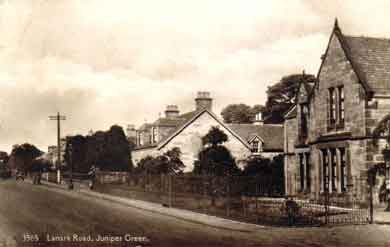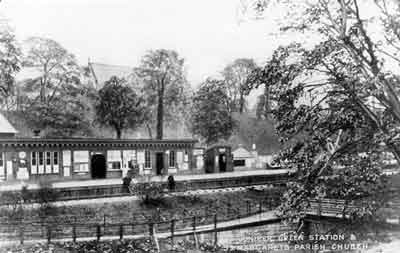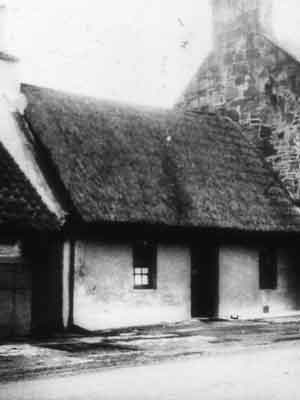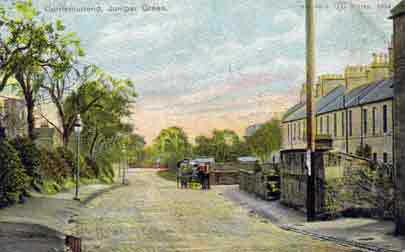Memories of Juniper Green
Irene Sharp remembers...
This reminiscence is based on an interview with Irene Sharp by Cliff Beevers on October 6th 2006
My family came to Juniper Green in 1928 and stayed in the first bungalow near the park on the corner of Park Road. Where these new houses are (facing the Village Hall) there was a line of cottages with lovely gardens looking onto the tennis courts. We moved to 519 Lanark road in 1935 or so.
519 Lanark road was built around 1878 and it has only had three owners: Mr Spears, my father and Phil and Lynn John. Mr Spears was a Baillie in Edinburgh and that is why they had a grand lamp post outside their house. I think he was a builder and his son was a doctor living in India. Before that in the 1800s there was a dairy farm here and my father would dig up cow horns occasionally. The house I'm in now was built in the garden of that house.
My mother had visited Juniper Green back in the early 1900s, But, she was back in Juniper Green when she got married! My great grandmother's daughters lived in Woodhall Terrace in the early 1900s.
The doctors of Juniper Green
The Sellars lived in the Bield before the Woodruffes and he was the local GP. They were there in 1932 and maybe even before that. He ran his practice from the house and originally he had been working with Dr Fowler who lived at the corner of Foulis Crescent and Lanark Road.
Dr Sellars had 3 daughters. My father was at school with him. Dr Sellars' wife tragically died when his youngest daughter was only 6 in the middle 1930s. She was killed in a car accident. Dr Sellars married again a sister from a nursing home in Edinburgh and they had 3 more children.
Dr Ross married the eldest of Dr Sellars' daughters and worked initially with his father-in-law. At the end of the War Dr Ross and his wife lived in the Bield too. They had a lovely garden with a tennis court in it.
Travel
I took the SMT bus to school which turned right at Gillespie and stopped at the Royal Infirmary and then I just walked down (to Watson's). My father took the bus too to his work in George Street, either the number 8 city bus or the SMT that went down George Street.
During the War my father used the railway as he was in the army and he had to attend meetings of the West Lothian Home Guard and that was in Atholl Crescent so he would take the train down to the Caley. I didn't use it. If I went to Colinton I would go by bus, there were some good shops there and the library.
Irene Thomson and I would go to school at Watson's together on our bikes, The trams would come to Colinton up on the left hand side and you had to be careful when cycling near the barracks as the road became quite narrow. At the Slateford end the trams stopped at the road where ASDA is today.
Shops in Juniper Green
Where the chemist is now there was a greengrocer run by Lizzy and Willie Forsyth, brother and sister. Some people found them grumpy but we found them very nice. Next door was the grocer William Scott and he was there up to about 1960 then Mr Smith came along.
In the post office when we first came to the village was a Miss Graham, she wore a cape and drove a scooter. She had a soft spot for Donald Matthieson the local painter. Miss Graham came along to the house when I was small to get a plant from the garden, I hadn't been well and she said to my mother "Give her prune paste!" If I meet Donald and he doesn't look well I say to him "Have you run out of your prune paste?" Then, Walter Scott took over the Post Office, he lived in Muirend Avenue and he also had the post office in Shandon. He was there until the Fishers took over.
Next to the post office was Juniper Cottage which was the police station. Next to it was a little shop, McNab the cleaner's. Then, a house and then Gillon's the butcher The lady who served in the butcher shop was Miss MacKinnon and her sister was a friend of my mother. Next to the butcher, where the flats are today (541 Lanark Road), there was an old old house and a long garden, it was there before the garage. Below it there was a little steep path going down and the house underneath there lived the local chimney sweep, Mr Hamilton.
Then comes the old St Margaret manse (547 Lanark Road), the dower house to Woodhall House. I remember the snuff mill too, there was a lovely smell and the old man who worked the mill had a moustache stained brown and his hair was brown.
Where the Building Society was (presently the funeral parlour) there was a bakery before the War, Graham's. They lived opposite the church (503 Lanark Road).
557 used to be thatched, a dairy. I remember sitting in my pram on the other side of the road watching them thatching. I think they sold milk but we got our milk delivered from Edinburgh.
Scott's the grocer's was Cattanach's when I was a child. Mr Cattanach had horses and a trap and he would deliver the groceries from his trap. The other shop (where the butcher shop is today) was empty until just before the War when it became a fish shop.
The cooperative store was always there at the top of the village with all its different parts but my mother didn't use it, she had a man come each week from R and T Gibson's of Princes Street, he took the order and then it was delivered.
School memories
Just around the corner in Baberton avenue was Miss Linton's sweetie shop. Mrs Benson took it over later. Miss Linton had an open fire at the back of the shop with little benches and the children who had come to school from far away, like Torphin or Wester Hailes, would bring sandwiches and she would make them cocoa. They would sit at the fire and have their lunch. I went to a private nursery in Colinton in Spylaw Bank Road. That was when I lived up by the park and I would go with Lucy Sellars and Nanette next door and the three mothers would take it in turns to take us to the nursery. There was also Priscillla MacKay, Dr MacKay's daughter, and another little girl from near the pub at Curriemuirend.
Juniper Green Ministers
The first one I remember was when I was young and he was called Mr Buchanan. He left to go to Fife. They bred dogs. He was a nice man. Then, we had this man Henderson and he was not so popular just at the beginning of the War. Some of his sermons didn't go down too well and he put up anti-war notices. My uncle and my father, climbed over his fence and pulled them down. At the end of the War he got a job as the principal of a theological college in New Zealand. He was a very tall man, about 6 foot seven inches.
The last minister of St Margaret's was Mr Davidson and his wife was related to the Carlyle's who are supposed to have stayed in the village. My mother told me that.
Characters in the village
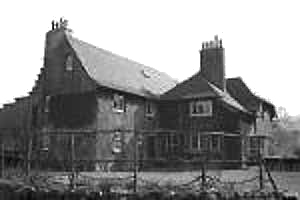
© Royal Commission on the Ancient and Historical Monuments of Scotland. Licensor www.scran.ac.uk
Lorimer House at 491 Lanark Road
Mr Bruce owned the paper mill and lived in Torduff (now Lorimer House). He had two wives. Mrs Bruce was a friend of my aunt. I remember my aunt and my mother whispering about what was going on. The second Mrs Bruce was very nice.
The fish wife, Maggie, who would stand at the corner of Baberton Avenue but she would come around to the houses too. She had a basket on her back with the fish in, a small basket on top and a board on which she would gut the fish.
The minister at Currie, Dr Stuart, he was very funny. He wore a big cape and a moustache stained with tobacco. He would talk to the youngsters on the bus. I told him one day that we had hens and he said he had a pullet that makes such a noise when it lays an egg that he christened her "Mrs so and so" from the Women's Guild because this lady when she does something for the Women's Guild she makes such a noise about it! His cockerels he called after the Edinburgh presbytery. His daughter Nan took the guides and during the war every Saturday there would be a country dance at the Gibson-Craig. We would go to it.
Juniper Green in the war
I spent the War years here in Juniper Green. When they bombed Clydebank the German planes followed the line of the valley. We could hear a constant stream of planes going over, you could hear a difference in the engine, German planes went "ahuhu ahuhu ahuhu" (describing a stuttering engine rhythm), whereas the British planes had a more continuous noise. There was one plane that crashed in the Pentlands, up on Hare Hill. We went up on our bikes to the bottom of Threipmuir to see if we could find any bits of the plane but the RAF were there stopping you going any further. A number of bombs were dropped on the Lang Whang and left craters on both sides of the road.
Winston Churchill was in Juniper Green during the War. At that time there was a siding at Balerno where the train could be kept in secrecy. He had been at a meeting in Edinburgh and word got out that he would be driving through the village to catch this train. We all stood on the pavement and watched, I was with my cousins. I saw him being driven past, probably around 1944.
The mills
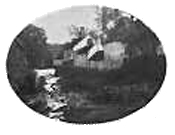
Mossie Mill across the Water of Leith in Colinton employed many folk from Juniper Green
I remember Mossie Mill, it used all sorts of cardboard and rags, it didn't make fine paper. There was a walkway through the mill, down from Curriemuirend, under the railway and across a little metal bridge. I remember in my pram being terrified down there as there was so much steam. There was the porage oats mill, Inglis mill and Woodhall mill.

